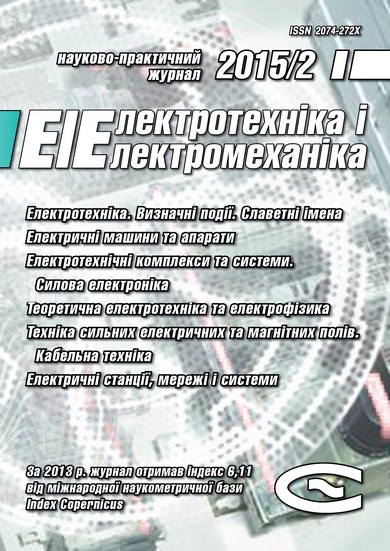INVESTIGATION AND CALCULATION OF VALLEYS OF OUTGOING FROM SUBSTATION GROUNDING CONDUCTORS FOR SHORT-CIRCUIT IN SINGLE-PHASE SHORT OF ELECTRICAL GRID
DOI:
https://doi.org/10.20998/2074-272X.2015.2.14Keywords:
substation, electrical safety, electromagnetic compatibility, grounding device, equivalent circuit, single-phase short-circuit current, distribution, algorithm, calculation, analysis, designAbstract
Introduction. Earthing device electrical substation in modern conditions must meet both the requirements of electrical safety of people and animals, as well as electromagnetic compatibility requirements established her electrical equipment. These requirements are intended to address issues of protection against surges and interference caused by lightning impulse currents and switching. Aim. To investigate the distribution of single-phase short-circuit current in the substation grounding devices. Task. On the basis of the proposed design scheme of substitution substation grounding device, consisting of a substation earthing system and «cable-supported» an algorithm for calculating the resistance of the grounding device substation and distribution of single-phase short-circuit current on the circuit elements. Method. Mathematical modeling and calculation engine. Results. On the basis of calculations and studies analyzed the current distribution of single-phase short-circuit between the substation earthing system and earthing «rope-reliance». Studies carried out for the actual range of variation of the circuit parameters, showed that the earthing resistance substation substantially affects the current distribution in the one-phase short circuit fault. For example, using the graph shows that with increasing resistance grounding system of "rope-supported" the proportion of single-phase short-circuit current flowing from the substation earthing increases, while the proportion of single-phase short-circuit current flowing from the grounding device supports decreases and vice versa. In addition, when rationing grounding systems at substations for the touch voltage is necessary to analyze all the possible modes of operation of the network, which is substationed. Conclusion. The results obtained are recommended to take into account in the design of grounding systems at substations.References
Pravila ulashtuvannya elektroustanovok. Rozdil 1. Zagal'nі pravila. Glava 1.7. Zazemlennya і zakhisnі zakhodi vіd urazhennya elektrichnim strumom [Rules of the device electroinstallations. Chapter 1. General rules. Grounding and protective measures against electric shock]. Kyiv, Mіnenergovugіllya Ukrayiny Publ., 2011. 72 p. (Ukr).
Viprobuvannya ta kontrol' pristroyiv zazemlennya elektroustanovok. Tipova іnstruktsіya. SOU 31.2-21677681-19:2009 [Test and control devices, electrical grounding. Standard instruction. SOU 31.2-21677681-19:2009]. Kyiv, Mіnenergovugіllya Ukrayiny Publ., 2010. 54 p. (Ukr).
GOST 12.1.038-82. Sistema standartov bezopasnosti truda. Elektro-bezopasnost'. Predel'no dopustimye znachenija naprjazhenij prikosnovenija i tokov. Chast’ 3 [State Standard 12.1.038-82. Occupational safety standards system. Electrical. Maximum allowable values of voltages of touch and currents. Part 3]. Moscow, IPK-standards Publ., 1996. pp. 237-243. (Rus).
Downloads
Published
How to Cite
Issue
Section
License
Copyright (c) 2015 V. I. Nizhevskyi, I. V. Nizhevskyi, B. Ynoyatov, S. Nasryddyny

This work is licensed under a Creative Commons Attribution-NonCommercial 4.0 International License.
Authors who publish with this journal agree to the following terms:
1. Authors retain copyright and grant the journal right of first publication with the work simultaneously licensed under a Creative Commons Attribution License that allows others to share the work with an acknowledgement of the work's authorship and initial publication in this journal.
2. Authors are able to enter into separate, additional contractual arrangements for the non-exclusive distribution of the journal's published version of the work (e.g., post it to an institutional repository or publish it in a book), with an acknowledgement of its initial publication in this journal.
3. Authors are permitted and encouraged to post their work online (e.g., in institutional repositories or on their website) prior to and during the submission process, as it can lead to productive exchanges, as well as earlier and greater citation of published work.





